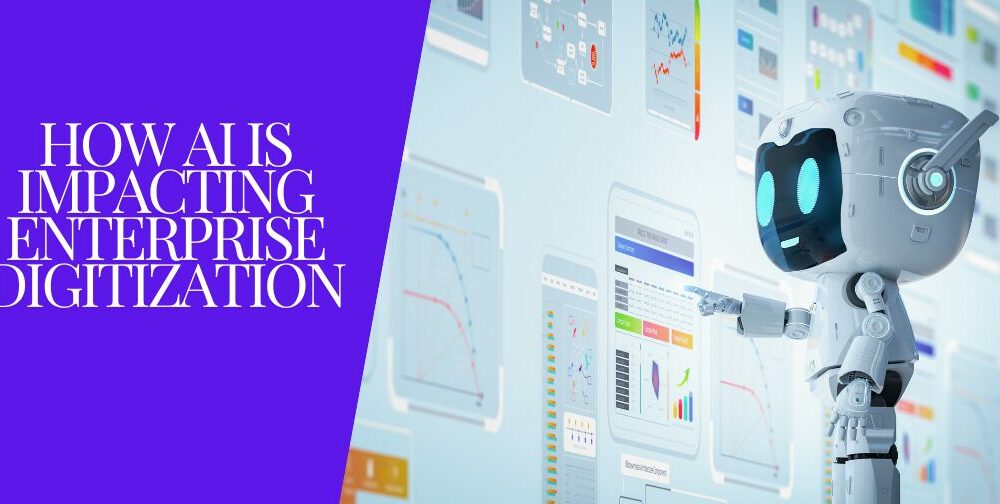How AI is Impacting Enterprise Digitization

In an era where digital transformation is no longer a choice but a necessity, enterprises around the globe are grappling with the need to integrate advanced technologies into their operations. The journey towards digitization has been both rapid and challenging, with a significant number of companies still lagging behind. According to a 2023 report by McKinsey, nearly 70% of companies have yet to fully digitize their operations, with many citing obstacles such as outdated legacy systems, data integration issues, and skill shortages.
Enterprise digitization really began in the late 20th century as businesses began adopting basic computer systems and transitioning from paper-based processes to digital record-keeping. The advent of the internet in the 1990s further accelerated this shift, introducing new possibilities for connectivity and e-commerce. The 21st century ushered in the age of cloud computing, big data, and artificial intelligence (AI), promising unprecedented levels of efficiency, innovation, and customer engagement.
Despite these advancements, the digital divide between industry leaders and laggards remains stark. The pandemic highlighted this gap, with digitally advanced companies adapting more swiftly to remote work, e-commerce, and digital service delivery. However, for many enterprises and government organizations, the path to full digitization remains fraught with challenges.
The rapid pace of advancements in artificial intelligence (AI) has expedited the need for enterprise digitalization in order for businesses to stay competitive and compete in global markets. To understand how AI’s potential impact on enterprise digitization, we spoke with S. Mohan, CEO of JumpTech Solutions Corp. Mohan, a serial tech entrepreneur with projects dating back to mid-90s, shared his insights on the evolutionary development of AI and its profound impact on businesses.
The Current State of AI in Enterprise Digitization
Mohan asserts that AI’s current role in enterprise digitization is transformative yet still in its early stages in many regions. “Enterprises employing AI at any scale are in their nascent stage in most countries,” he notes. However, the potential benefits are already clear. AI is already capable of automating routine tasks, whether custom or generic, and creating efficiencies throughout organizations in terms of workforce resource allocation. Additionally, capabilities such as enhanced data analysis allows employees to focus on more strategic roles, leveraging AI-driven analytics for real-time insights and informed decision-making.
“AI applications can free employees for strategic roles while AI-driven analytics provide real-time insights for informed decision-making,” Mohan explains. AI-powered chatbots are revolutionizing customer support, offering instant responses and personalized marketing to boost engagement. Additionally, AI’s capabilities extend to enhancing cybersecurity, optimizing supply chain management, predictive maintenance, and streamlining HR processes.
Long-Term Outlook on Implications
Looking ahead, Mohan anticipates even more sophisticated AI integration. “AI could handle more complex tasks such as performing tasks that require robotic precision under human supervision, making sophisticated analyses, and providing personalized information and plans.” As AI systems prove their reliability and safety, they will gain more trust and acceptance, prompting the development of regulatory frameworks to support their use in critical functions.
“With proven reliability and safety, AI systems may gain more trust and acceptance, leading to increased regulatory frameworks that support their use in critical functions,” Mohan says. This regulatory environment will be crucial for ensuring that AI’s benefits are maximized while mitigating potential risks.
The 10-20 year outlook for the potential of AI is even more profound. Mohan envisions a future where AI could potentially replace professionals if it reaches a level of sophistication that includes human-like understanding, empathy, and adaptability. “If AI reaches a level of sophistication where it can perform all the cognitive, emotional, and ethical tasks currently handled by professionals, it could potentially replace these professionals,” he muses. However, he acknowledges that such capabilities are currently beyond AI’s reach.
Beyond AI’s impact on the workforce, he identified several advancements in AI technology that are expected to drive the next wave of enterprise digitization. “In the Medium Term, advancements in natural language processing, AI piloted machine learning, IoT integration, and business process automation are likely to be the main drivers of the next wave of enterprise digitization.”
When it comes to integrating AI into legacy systems versus modern digital infrastructures, Mohan notes that the latter offers greater flexibility and ease of integration. “Integrating AI into legacy systems involves overcoming compatibility, data quality, scalability, and security challenges, often requiring modifications and infrastructure upgrades,” he explains. In contrast, modern infrastructures leverage cloud computing, unified data platforms, and advanced security measures to better incorporate AI capabilities.
Overall, the introduction of AI systems into enterprise-scale organizations brings several key benefits to enterprise-scale digitization projects. According to Mohan, these include innovation, operational efficiency, and cost reductions, which make enterprises more competitive and agile in the digital age. “These key benefits make enterprises more competitive and agile in the digital age,” adds Mohan.
Risks of AI in Digitization Projects
Despite its advantages, integrating AI into enterprise digitization strategies is not without challenges. Mohan highlights issues such as data quality, technical complexities, and skill shortages. “Enterprises face significant challenges when integrating AI into their digitization strategies, including data quality, technical complexities, and skill shortages,” he states. Effective AI implementation requires high-quality, integrated data, but data silos and privacy concerns can impede progress. Additionally, integrating AI with legacy systems necessitates infrastructure investments and technical modifications.
Security is another critical concern. AI systems can be targets for cyber-attacks, including data poisoning and theft. “The use of AI in enterprise digitization raises significant security concerns as the technology becomes more integrated,” Mohan warns. To mitigate these risks, companies should implement robust security measures, including regular audits, encryption, and access controls. “Specific defenses against AI-driven attacks include using AI to enhance threat detection, deploying machine learning models to recognize patterns of malicious behavior, and continually updating defenses based on the latest threat intelligence.”
What Does it All Mean?
Mohan’s insights underscored the transformative potential of AI in enterprise digitization. In the short term, AI is already automating routine tasks, enhancing data analysis, and improving customer experiences, freeing employees for more strategic roles. However, further advancements in AI will enable businesses to handle more complex tasks, increase operational efficiency, and foster greater trust and regulatory frameworks, with the ultimate possibility of AI reaching human-like understanding, empathy, and adaptability could redefine professional roles altogether.
As AI technologies continue to evolve, businesses that strategically integrate these capabilities will be well-positioned to thrive in the digital age. By embracing AI, enterprises can not only enhance their operational efficiencies and reduce costs but also stay competitive in an increasingly digitized world. Mohan’s vision for the future of AI in enterprise digitization serves as a roadmap for businesses looking to navigate this complex yet promising landscape.





